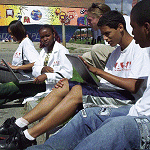They Get the Picture
##AUTHORSPLIT##<--->
Students' familiarity with digital cameras is allowing teachers to augment classroominstruction with a myriad of unconventional activities.
DIGITAL CAMERAS AREN'T just for taking picturesof friends and family anymore. Today's classrooms usethem for a spate of projects, and not merely in photographyclasses—instructors are incorporating digital cameras intoevery subject and every aspect of instruction.
Witness how Springfield Township School District in Oreland, PA, is utilizing digital cameras for more than fine arts. As a recipient of a Pennsylvania Classrooms for the Future grant, the district has outfitted select classrooms at Springfield Township High School with resources including laptops, digital still cameras, video cameras, webcams, speakers, interactive whiteboards, and projection units.
English teacher and CFF technology coach Ken Rodoff says digital photography is enabling students to learn in a way that is native to them, one that is more visually oriented. One sample use, he offers, is a whole new way to learn vocabulary words. He says the students in his English classes are able to visualize new words and concepts through images they post online: "The word plethora, for instance. Students can go out, take a picture that they feel is a visual representation of that word, and then upload it to [social networking site] Flickr. Then other students can annotate the image to expand the meaning."

IMAGE CONSCIOUS
Springfifield Township
students posted this visual
depiction of the word
concord, meaning harmony.
Rodoff explains that once students' photos are uploaded onto the site, educational opportunities are opened up. "When students post their images to Flickr, they can never post them and leave them alone," he says. "The teacher asks questions about the images and how they represent what they are intended to represent. Teachers are now affording themselves an opportunity to use those images as a springboard into lessons."
Digital cameras also are being used to complement students' social networking activities while at the same time helping them study literary works. "Now suddenly, my students are getting a deeper understanding of Hamlet as they are working on their blogs, and they want to get images to include with their interpretation of the story," Rodoff says.
Indeed, social networking has been the main catalyst for students' use of digital photography. Sites such as Flickr, MySpace, and Facebook integrate photos into their overall experience, and the decreasing cost of digital cameras and the ubiquity of camera phones have made the technology almost second nature to today's students. This, many educators note, has made using digital cameras in the classroom a more comfortable learning experience.
A recent report by Grunwald Associates in conjunction with the National School Boards Association reveals the degree to which social networking is a way of life with today's kids. The report notes that 9- to 17-year-olds who took part in the study spend almost as much time during the week using social networking tools and websites (nine hours) as they spend watching TV (10 hours).
In the study, kids ranked digital photography among the technologies they most commonly use during their social networking activities. Twenty-four percent of those surveyed said they post photos or artwork created by others at least once a week, while 22 percent said they post their own artwork at least that often. Overall, a whopping 49 percent said they had uploaded artwork or photos at least once. Such numbers underscore Rodoff's belief that photography can enhance the academic experience.
"What we are focusing on that is new is students' ability to create meaningful content in an academic environment," he says. "They are creators of content through their other sites, and this is a natural extension.
 site seeing
site seeing
Australian educator and technologyconsultant Keith Lightbody offersteachers a how-to guide on the useof digital cameras in the classroom,including tips on choosing the rightkind of camera.
"The opportunity for instructors to be able to use digital photography in the design and planning of instruction, in addition to using it in impromptu and extemporaneous instruction, makes for a much more interesting learning experience, for both the students and the teachers."
But even in environments apart from social networking, digital cameras are helping students express themselves in ways that go far beyond the traditional learning experience. In a more classic use of the technology, middle school students at Learning Community Charter School in Jersey City, NJ, are able to participate in a digital photography elective as part of a partnership with Wingspan Arts, a New York City-based nonprofit that brings professional artist-educators into the school system. The students work with their Wingspan teacher, Laura Mozes, twice weekly for 13-week sessions to learn how to take high-quality photos with the school's digital cameras, and then manipulate the images using Adobe Photoshop Elements software.
The program gives students a creative outlet and pride in their skills, Mozes explains. "Using Photoshop, students can take a photo that starts out not very interesting and make it into something interesting," she says. "It's quite impressive to see how creative they can be, and it's a confidence builder because people see the different effects in the photos and say, ‘How did you do that?'"
The school's principal, Susan Grierson, agrees. "For any kid, it's an exciting and a wonderful medium," she says, "and for this age group in particular it transcends social relationships and gives them a lot of confidence. It's a private, safe medium for them, and it is lovely to see their personalities emerge through their work."
The digital photography class is part of Wingspan Arts' Arts Electives Program. Each student in the class is given a digital camera and a laptop to use during the session.
"It's nice to be able to combine 21st-century technology with a traditional skill such as photography," Grierson says. "Using a digital camera, the immediacy of the whole thing is such a thrill for them."
Charlene O'Hanlon is a freelance writer based in New York.
This article originally appeared in the 01/01/2008 issue of THE Journal.